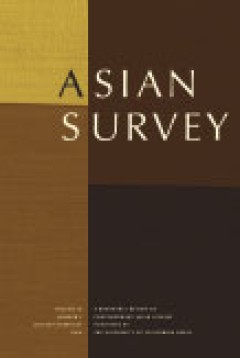Filter by

For want of a nail : Negative persuasion in a party leadership race
Should party leadership candidates communicate their policy positions to the party’s electorate? And should they do so when their own ideal position is outside their party’s mainstream? This article presents evidence from a field experiment into the communication of controversial policy positions through direct mail. Working with a front-running campaign during the race for the leadership of th…
- Edition
- Vol. 17 no. 1, January 2011.pp. 45-65
- ISBN/ISSN
- 13540688
- Collation
- -
- Series Title
- Party Politics
- Call Number
- -

Women, parties and platforms in post-industrial democracies
Will women transform party politics? As a group of relative newcomers to parties, women may contribute to shaping parties’ policy agendas and to changing party rules. A party-level perspective allows for examination of the national- and party-level contextual influences that condition the effect of women on party platforms. Systematic analysis of a broad range of 142 political parties in 24 pos…
- Edition
- Vol. 17 no. 1, January 2011.pp. 66-92
- ISBN/ISSN
- 13540688
- Collation
- -
- Series Title
- Party Politics
- Call Number
- -

Turnout and the (effective) number of parties at the national and district le…
Blais (2006) and Blais and Aarts (2006) in their review essays on voter turnout call attention to a striking puzzle about the link between electoral systems and turnout, namely that, ceteris paribus, proportional representation (PR) systems with many parties appear to have higher national-level turnout than single-member district (SMD) plurality systems with few parties, yet turnout does not in…
- Edition
- Vol. 17 no. 1, January 2011.pp. 93-117
- ISBN/ISSN
- 13540688
- Collation
- -
- Series Title
- Party Politics
- Call Number
- -

Social democrats, unions and corporatism : Denmark and Sweden compared
A number of recent studies have documented weakening ties between social democratic parties and trade unions. This article is concerned with the effects of weakening party— union ties on policymaking. In many classic studies of corporatism it has been argued that this mode of policymaking depends on strong ties between social democratic parties and trade unions. In this article, we argue, in co…
- Edition
- Vol. 17 no. 1, January 2011 .pp. 118-134
- ISBN/ISSN
- 13540688
- Collation
- -
- Series Title
- Party Politics
- Call Number
- -

Outsider parties in government in Western Europe
Over the past two decades, a growing number of ‘outsider parties’ have entered governing centre-left and centre-right coalitions across Western Europe. In this introduction, we first define outsider parties as those which — even when their vote-share would have enabled it — have gone through a period of not being ‘coalitionable’, whether of their own volition or that of other parties in the sys…
- Edition
- Vol. 17 no. 4, July 2011.pp.443-452
- ISBN/ISSN
- 13540688
- Collation
- -
- Series Title
- Party Politics
- Call Number
- -

Of goals and own goals : A case study of right-wing populist party strategy f…
Using internal party documents and semi-structured interviews with over 200 activists of the Freedom Party of Austria, this article examines (anticipatory) adaptation in the intra-party and governmental arenas when this right-wing populist party switched its primary goal from populist vote maximization to office. It suggests such parties’ success will owe much to their leaderships’ capacity to …
- Edition
- Vol. 17 no. 4, July 2011.pp. 453-470
- ISBN/ISSN
- 13540688
- Collation
- -
- Series Title
- Party Politics
- Call Number
- -

Di lotta e di governo : The Lega Nord and Rifondazione Comunista in office
Since 1994, Italian politics has seen a number of coalitions including parties whose identity has been strongly based on their ‘outsider’ status as uncompromising opposition movements which would not previously consider government participation. This article examines the contrasting experiences in office of two such parties: the regionalist populist Lega Nord (LN) and the radical left Rifondazi…
- Edition
- Vol. 17 no. 4, July 2011.pp. 471-487
- ISBN/ISSN
- 13540688
- Collation
- -
- Series Title
- Party Politics
- Call Number
- -

The radical left in coalition government : Towards a comparative measurement …
This article raises questions about how best to assess the performance of radical left parties participating in coalition governments. Drawing in part on interviews (see Appendix 1), it covers parties that have participated in coalition government (Cyprus, Finland, France, Ireland, Italy, Norway), or have acted as ‘support parties’ (Denmark, Sweden), or are debating the ‘pros and cons’ of coali…
- Edition
- Vol. 17 no. 4, July 2011.pp. 488-504
- ISBN/ISSN
- 13540688
- Collation
- -
- Series Title
- Party Politics
- Call Number
- -

From protest to power : Autonomist parties in government
In many Western European states, an increasing number of autonomist parties are taking part in government at state and regional levels. To date, however, scholars have paid little attention to the repercussions of government incumbency for these actors. This article aims to take a first step towards redressing this oversight. Based on an extensive literature examining political parties in gover…
- Edition
- Vol. 17 no. 4, July 2011.pp. 505-524
- ISBN/ISSN
- 13540688
- Collation
- -
- Series Title
- Party Politics
- Call Number
- -

Party system classification : A methodological inquiry
Despite the recent spread of multi-scale approaches to party system classification, the most widely accepted criterion has always been the number of parties, often defined in terms of their relative sizes. Building on the existing body of qualitative classifications and quantitative techniques, this article proposes a method that can be used for defining party system types in operational terms,…
- Edition
- Vol. 17 no. 5, September 2011.pp. 539-560
- ISBN/ISSN
- 13540688
- Collation
- -
- Series Title
- Party Politics
- Call Number
- -

The importance of party ideology : Explaining parliamentarian support for pol…
Party gender quotas are rules voluntarily adopted within political party structures that aim at securing a set percentage of women to appear on candidate lists in elections for political office. Although parliamentarian support is critical to the adoption and enforcement of party gender quotas, empirical studies of parliamentarian opinion on this matter are few, and none are concerned with coun…
- Edition
- Vol. 17 no. 5, September 2011.pp. 561-579
- ISBN/ISSN
- 13540688
- Collation
- -
- Series Title
- Party Politics
- Call Number
- -

Organization and institutionalization of Russia’s political parties in 1905…
In this article, we use logit models to examine the role of the major characteristics of a political party's organization, (1) legitimation, (2) penetration/diffusion, (3) charisma, (4) ideology and (5) centralization/decentralization, in the institutionalization of parties in both pre-Soviet and post-Soviet Russian national parliamentary elections. The article begins by situating this research…
- Edition
- Vol. 17 no. 5, September 2011.pp. 581-609
- ISBN/ISSN
- 13540688
- Collation
- -
- Series Title
- Party Politics
- Call Number
- -

Electoral volatility, competition and third-party candidacies in US gubernato…
Third-party participation in plurality elections should be rare, given the low probability of electoral success. In the United States, the entrenched two-party system makes third-party candidacies especially puzzling. We develop a general theory of these candidacies based on the electoral context, focusing on electoral competition and volatility. When electoral competition is either low or high…
- Edition
- Vol. 17 no. 5, September 2011.pp. 611-628
- ISBN/ISSN
- 13540688
- Collation
- -
- Series Title
- Party Politics
- Call Number
- -

Dual accountability and the nationalization of party competition : Evidence f…
This paper assesses the extent to which party systems are nationalized in four federations. In doing so, the research addresses two questions. First, is dual accountability operational across decentralized countries, or do sub-national voters turn to national cues as a means to economize in a complex information environment? By bringing a cross-national dataset to bear on this question, we are …
- Edition
- Vol. 17 no. 5, September 2011.pp. 629-653
- ISBN/ISSN
- 13540688
- Collation
- -
- Series Title
- Party Politics
- Call Number
- -

Pathways to party unity : Sanctions, loyalty, homogeneity and division of lab…
The study of party unity and its determinants is conceptually confusing, with terms such as ‘party discipline’ and ‘party cohesion’ used to denote both dependent and independent variables. Moreover, while the literature recognizes both anticipated sanctions and homogeneity of preferences as pathways to party unity, it ignores possibilities such as party loyalty and the division of labour within…
- Edition
- Vol. 17 no. 5, September 2011.pp. 655-672
- ISBN/ISSN
- 13540688
- Collation
- -
- Series Title
- Party Politics
- Call Number
- -

Rallying around the flag or railing against the government? Political parties…
This article analyses the reaction of mainstream political elites to acts of terrorism and assesses whether opposition parties will rally around the flag, much like they do during military or diplomatic crises. A statistical analysis, conducted on 181 terrorist events in five countries (France, Germany, Spain, the United Kingdom and the United States) over the period 1990 to 2006, indicates tha…
- Edition
- Vol. 17 no. 5, September 2011.pp. 673-698
- ISBN/ISSN
- 13540688
- Collation
- -
- Series Title
- Party Politics
- Call Number
- -

Japan's Involvement in Asia-Centered Regional Forums in the Context of Relati…
Abstract Against China's attempts at cultivating multilateral forums to augment and institutionalize its influence in Central, Northeast, and Southeast Asia, Japan's major foreign policy challenge now is how to secure its own interests in these forums while balancing its relations with China and the United States.
- Edition
- Vol. 51, No. 3, May/June 2011, pp. 407-429
- ISBN/ISSN
- 00044687
- Collation
- -
- Series Title
- Asian Survey
- Call Number
- -

Malaysia's Foreign Policy under Najib
Abstract Malaysian foreign policy and diplomacy under Mahathir Mohamad were both grandiose and pragmatic, if not audacious. Faced with a changing and uncertain global environment, current Prime Minister Najib Razak has formulated external strategies expected to sustain Malaysia's economic progress to ensure regime legitimacy and political stability.
- Edition
- Vol. 51, No. 3, May/June 2011, pp. 429-452
- ISBN/ISSN
- 00044687
- Collation
- -
- Series Title
- Asian Survey
- Call Number
- -

Mongolia's Environmental Security
Abstract This article examines China's “unconscious power” over Mongolia's environmental sector. It argues that Ulaanbaatar's state weakness and Chinese unconscious power constitute a mutually reinforcing threat to Mongolia's environmental security.
- Edition
- Vol. 51, No. 3, May/June 2011, pp. 453-471
- ISBN/ISSN
- 00044687
- Collation
- -
- Series Title
- Asian Survey
- Call Number
- -

Globalization, Democracy, and the Public Sector in Asia
Abstract In this era of globalization, does democracy in Asia have a mediating impact on a country's public sector? As the first empirical analysis focused solely on Asian countries, this paper finds that, in general, democracies are associated with a larger government. In particular, democracies more exposed to the global trade have larger public economies. This is not the case, however, in d…
- Edition
- Vol. 51, No. 3, May/June 2011, pp. 472-496
- ISBN/ISSN
- 00044687
- Collation
- -
- Series Title
- Asian Survey
- Call Number
- -
 Computer Science, Information & General Works
Computer Science, Information & General Works  Philosophy & Psychology
Philosophy & Psychology  Religion
Religion  Social Sciences
Social Sciences  Language
Language  Pure Science
Pure Science  Applied Sciences
Applied Sciences  Art & Recreation
Art & Recreation  Literature
Literature  History & Geography
History & Geography